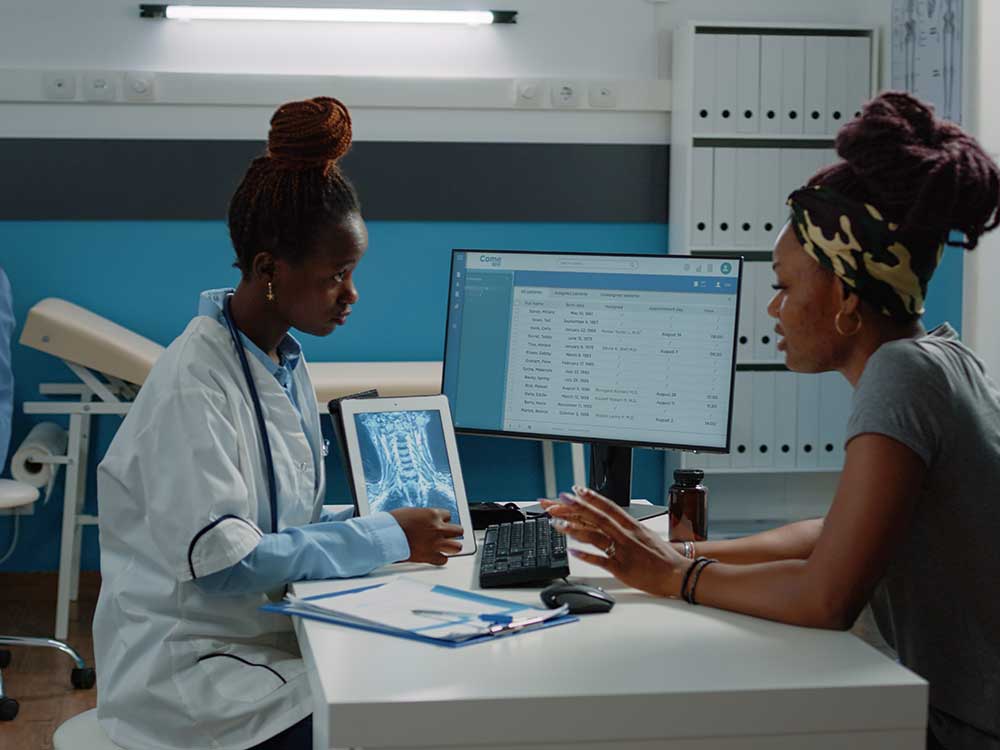Just How to Boost Performance in Medical Administration with Modern Devices
Just How to Boost Performance in Medical Administration with Modern Devices
Blog Article
Innovations in Medical Administration: Just How Modern Technology Is Reshaping Health Care Monitoring
The landscape of medical care management is undertaking a profound change, driven by technical improvements in medical management. Electronic Health Records (EHR) have actually become the foundation of efficient individual data monitoring, while telemedicine bridges ranges, making healthcare easily accessible to even one of the most remote locations. Man-made intelligence is not just an advanced concept however a contemporary tool that customizes person treatment and streamlines administrative tasks. As these technologies take center stage, a critical concern emerges: how will these modern technologies even more redefine the health care experience for both suppliers and patients in the coming years?
Development of Electronic Health Records
Over the past couple of years, the development of digital health and wellness documents (EHRs) has substantially transformed the landscape of medical management. Initially created to digitize person records, EHRs have actually expanded beyond their initial range to come to be important tools in simplifying healthcare processes, boosting individual care, and improving administrative efficiencies. The transition from paper-based systems to EHRs has lowered redundancies, decreased mistakes, and assisted in seamless details sharing throughout different doctor, consequently allowing comprehensive and worked with individual care.
EHRs have actually presented a paradigm change in health care monitoring by integrating clinical, management, and monetary information, therefore enabling even more informed decision-making. The ease of access of real-time person data encourages healthcare experts to make prompt diagnostic and treatment decisions, better boosting client results. Additionally, EHRs support the execution of evidence-based methods by providing accessibility to the most up to date clinical research and therapy standards directly within the professional process.
The government incentives and guidelines have actually accelerated EHR adoption, making certain compliance with requirements that protect individual personal privacy and data safety and security. As the healthcare market proceeds to welcome digital change, EHRs stay at the center of advancement, driving efficiency and enhancing the total top quality of healthcare delivery.
Improvements in Telemedicine
Telemedicine has actually swiftly progressed in recent years, fundamentally altering the way health care services are provided. This improvement is greatly credited to technical innovations that have actually increased accessibility to treatment, especially for people in remote or underserved locations. Telemedicine platforms assist in real-time examinations in between individuals and doctor, thereby reducing the requirement for in-person sees and dramatically lowering delay times.
The combination of video conferencing, mobile health applications, and remote surveillance tools has actually improved the scope of telemedicine. Patients can currently handle chronic conditions with continuous surveillance, obtain timely assessments, and access professional treatment without geographical constraints. This shift has not just better individual complete satisfaction however has actually likewise enhanced healthcare operations and resource allocation.
Moreover, telemedicine has actually played an essential function in public health, specifically during pandemics, by minimizing the threat of infectious condition transmission. Regulative advancements have better supported telemedicine's spreading, with lots of countries modifying plans to enable more comprehensive insurance protection for online visits.
Regardless of obstacles such as digital proficiency and data protection, the continuous growth of telemedicine promises to maintain its trajectory as a cornerstone of contemporary medical care administration, using a more accessible and effective healthcare distribution version.
Artificial Intelligence in Medical Care
Structure on the technological advancements seen in telemedicine, fabricated intelligence (AI) is rapidly becoming a transformative pressure in health care management. AI modern technologies use significant enhancements in efficiency, accuracy, and decision-making capabilities. Among the most compelling applications of AI in medical care is predictive analytics, which makes it possible for health care managers to expect patient needs, enhance resource allowance, and improve client results. By assessing huge datasets, AI algorithms can determine patterns and anticipate prospective health situations, allowing proactive intervention.

One more notable application remains in individualized medication, where AI description assists in customizing treatments to individual patient profiles by analyzing hereditary, way of living, and environmental aspects (medical administration). As AI remains to evolve, its integration into healthcare management assures to enhance operations, minimize expenses, and ultimately boost the quality of treatment given
Enhancing Data Security Measures
As health you can try this out care companies progressively depend on digital systems for taking care of patient data, the requirement for durable information safety and security actions has actually expanded tremendously. Data violations not just jeopardize patient privacy yet also lead to significant economic losses and damages to institutional credibilities.
Medical care organizations are implementing multi-layered safety frameworks to reduce threats. File encryption modern technologies guarantee that delicate data continues to be inaccessible to unapproved customers, both during transmission and storage space. The adoption of blockchain modern technology presents an encouraging opportunity for boosting data stability and traceability, giving an unalterable record of all deals.

Educating team on cybersecurity ideal techniques is just as crucial. Awareness programs equip healthcare employees with the expertise to identify and report potential risks, such as phishing attempts. By prioritizing data security, clinical managements can secure individual info and preserve count on.
Improving Client Communication Equipment
While durable information protection measures are fundamental in securing patient info, similarly essential is the improvement of patient interaction systems Going Here to make sure efficient healthcare delivery. In the advancing landscape of medical care administration, technological innovations are playing an essential role in changing exactly how healthcare service providers interact with individuals. Efficient interaction systems not only boost individual fulfillment but additionally enhance professional results by ensuring prompt and accurate details exchange.
This integration allows clients to access their clinical details securely, schedule visits, and interact with medical care providers effectively. In addition, the usage of telemedicine platforms has expanded access to health care services, especially for those in remote locations or with flexibility obstacles.
Moreover, synthetic intelligence-powered chatbots are being progressively used to give instantaneous feedbacks to client inquiries, using a smooth interaction experience. By leveraging these technical advancements, doctor can cultivate even more tailored person communications, inevitably bring about boosted individual interaction and adherence to treatment plans.
Conclusion
Telemedicine enhances medical care availability for remote populations, while man-made knowledge automates tasks and individualizes client involvement. Collectively, these innovations drive efficiency, minimize costs, and raise the top quality of health care distribution, reshaping business procedures in the health care sector.
Report this page